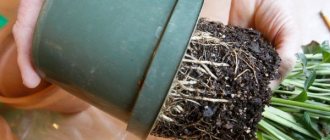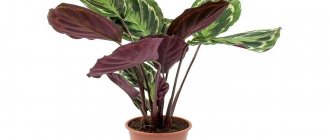Calathea can justifiably be considered the emerald of any flower collection - both among famous florists and ordinary people. But before you grow this tropical flower at home, you need to clearly understand that you will have to care for it sensitively and for a long time.
Dear readers! For you, we have created communities on social networks in which useful articles and interesting ideas are published several times a day! Subscribe and receive useful content in a convenient format!
True, none of the care requirements is impossible. Otherwise, we would be able to see Calathea exclusively in the places of its historical growth (in the tropics and subtropics), or in real pressure chambers maintaining the necessary climate artificially. But this, of course, is far from the case.
Other names for Calathea
The botanical name - Calathea - has become very widespread not only in the scientific community, but also in life.
INTERESTING. The name of this flower comes from the Greek word “calathos”, which literally means “basket”. The fact is that in ancient times baskets were woven from Calathea leaves.
But, perhaps, you can find another equally popular name for this flower. It is often called a prayer tree . Thanks to special pads located in the thickenings of the leaf petioles, Calathea has the ability to turn the foliage according to the movement of the sun.
But the main feature that the ancients noticed and why they dubbed the flower a prayer flower is the ability to lift and join the leaves together before rain or in the evening after sunset.
This action looks as if the flower is folding its leaves-palms in a prayer gesture.
Calathea and its features
The homeland of calathea is the moist equatorial forests of Africa, Central and South America. The culture belongs to the Marantaceae family. A distinctive feature of all plants in this group is their requirement for heat, light and high air humidity. Calathea grows at home up to 65-75 cm in height. The plant has many large leaves that seem to grow directly from the ground. But this is not so - on the surface there is a vertical stem only 2-3 cm long. The internodes are located almost close to each other, and a rosette of leaves on long petioles is formed in them.
Calathea leaves
The shape of the leaf blades can be lanceolate or oval-rounded, the edges can be smooth or wavy. Their size reaches 20-30 cm in length. The green surface of different shades is painted with chaotic stripes and spots. Patterns come in all tones:
- white;
- silver;
- yellow;
- orange;
- pink;
- red
The underside of the leaf blade is often painted with purple-red patterns, which adds brightness and originality to the flower. In its center there is a thick, very strong midrib. Translated, calathea means “basket”. Residents of the tribes of the humid equatorial forests still use arrowroot leaves as a durable material for weaving various products.
In common parlance, calathea is called the “prayer flower” because of the characteristic feature of the plant. At sunset, the leaves stretch upward towards the last rays of the sun, touching each other like palms in prayer. In the morning they again take a horizontal position and are motionless until the next evening.
Every year, calathea forms only 5-6 young leaves. Their lifespan is about a year. With proper care, the crop blooms for 2-3 weeks. Flowering time depends on the species. The peduncle is formed in the axils of the leaves. The inflorescence of the spike consists of small sessile flowers on the central axis. They have white, orange, dark purple bracts. Most types of calathea have inconspicuous inflorescences, but there are beautifully flowering varieties.
The rhizome of the flower is capable of storing water and nutrients thanks to stolons - small spherical growths. Calathea is able to live for some time in an unfavorable environment at the expense of root reserves. Stolons help the flower to more easily survive transplantation and propagation by dividing the bush.
Caring for Calathea after purchasing from a store
To begin with, don’t hesitate - any variety of Calathea will be oh so difficult to care for. But it has been noted for sure - if you have little experience, it is better to start with Kalotea Makoya . It is very common primarily because of its relative unpretentiousness. But Calathea Saffron and Crocata are the most demanding and the most capricious to any little things.
Remember that the biggest and most common problem that causes Calatheas to die is dry air in the apartment. In second place is lack of light or direct sunlight on the flower.
Of course, before purchasing, you need to find a place where there will be the most light during the day. But protect the flower from direct sun with screens or other improvised objects.
You can humidify the air by frequently spraying water near the plant, as well as placing saucers of water for natural evaporation of the liquid. Now that the place is ready, you can buy your first Calathea in the store.
Remember that quarantine is required for this plant. You need to wait 1-2 weeks without taking any action to replant, fertilize, etc. It is even recommended to water Calathea not immediately, but three days after purchase, when the plant has more or less adapted to its new location.
During this quarantine time, it will become clear whether the flower was grown in the store correctly. All possible fungi, infections, diseases and pests in new conditions will immediately make themselves felt.
ON A NOTE. In the future, Calathea will need to be transplanted into completely new soil. To do this, carefully remove the flower with a lump of earth and slowly shake off the soil from the roots. The new container should be selected wider than the previous one by about 5-6 cm.
How to replant calathea at home
Transplanting calathea
During its life, calathea releases toxic substances into the soil. The young plant must be replanted annually. Bushes older than 4 years are replanted once every 2 years. You need to replant calathea at home in early spring, following the algorithm:
- Water thoroughly the day before transplanting.
- Pour boiling water over a new flower pot.
- Fill 1/3 of the container with drainage (expanded clay, small crushed stone, broken brick).
- Sprinkle it on top with wood ash or crushed activated carbon (an additional measure against root rotting).
- Cover the drainage with soil with a layer of 2-3 cm.
- Carefully remove the bush from the old pot by gently pulling at the base of the petioles.
- Shake the soil off the roots.
- Rinse the root system under running water.
- Inspect the roots, remove rotten and damaged specimens.
- Cut off wilted, dry leaves.
- Treat the cut areas with a 1% solution of potassium permanganate (1 g per 100 ml of water).
- Place the plant in the center of the bowl, carefully spreading the roots on the surface of the ground.
- Fill the soil up to the edge of the pot. Slightly crush the substrate in the area of the stem to stabilize the bush.
- Water generously. If the soil settles, add more.
- Place the flower pot in a cool place. Water the next time no earlier than after 8-10 days.
Soil for calathea
The ideal substrate for calathea is a ready-made soil mixture for plants of the arrowroot family. Suitable soil for azaleas or rhododendrons. At home, you can prepare the soil mixture yourself. To do this, mix turf soil, humus, peat and coarse sand in a ratio of 2:1:1:1. A prerequisite is that the soil must be slightly acidic or neutral. Before use, the soil must be calcined in the oven for 15-20 minutes to disinfect.
Choosing a pot
Calathea does not need a deep pot, since the root system of the crop is close to the soil surface. She feels great in a bowl - a shallow container with wide edges, a narrow bottom, in which drainage holes are made. It is better to choose a pot made of unglazed ceramics. This material allows air to pass through well, which is very important for the root system of calathea.
Growing conditions
Contrary to what might already seem to the contrary, Calathea is a completely terrestrial plant. Just with your whims and requests. But they are all standard: the right light, precise dosage of watering, maintaining humidity.
Temperature
It is obvious that Calathea prefers warmth, because we remember that it originated from the tropical zone. This means that in summer it needs at least +20°C, and in winter within +15-18°C.
IMPORTANT! Due to the fact that Calathea requires a constant temperature without sudden changes, do not place it in places where there are drafts!
Air humidity
When growing Calathea, you will have to very carefully monitor the air humidity in the room. It is necessary to maintain this indicator from 90%.
Firstly, you will have to put into practice constant spraying of water from a spray bottle - up to 3-4 times a day. Moreover, this is typical for both summer and winter, when the air is strongly dried by working batteries. When spraying water, try to get as little water on the flower itself, its leaves and flowers. Point the sprinkler to the sides.
BY THE WAY , constant spraying can be left in the hands of automation. Today there are many offers for room humidifiers.
Secondly, it is advisable to leave saucers or any other container with water next to the flower. Humidity will be higher due to natural evaporation of liquid.
Lighting
Don't forget about lighting. For Calathea, it is important to observe two points: find the area that is maximally illuminated during the day and protect the flower from direct sunlight.
What kind of pot does a flower need?
In principle, you should not tear the veins, looking for some special dishes for your Calathea. Any container that you can find on the market will do.
Take only one piece of advice: when choosing between a clay and plastic pot, give preference to the second. Clay dishes absorb moisture, which increases the risk of liquid stagnation in the pot, which means putrefactive processes in the roots.
Choosing a place to put a flower pot
Some gardeners easily grow Calathea on windowsills. When choosing this option, it is optimal to give preference to western, eastern or southern windows. There will be as much light as possible during the day. However, the window then needs to be protected from direct sun by a screen. The second point is that it is advisable not to open the window, as drafts will harm this plant.
Most often, Calathea can be found not on window sills, but in specially designated corners of rooms, along passages, and walls. Yes, it is more difficult to organize high-quality lighting there, but there is no need to fence off the plant from the direct sun, and there are less drafts in the corners.
The lack of the same light can be easily circumvented, for example, by artificial supplementary lighting.
What does it look like in the interior?
The most remarkable part of Calathea is its leaves. Then the flowers. The most interesting thing is that the leaves can differ dramatically from variety to variety. But in any case, the plant will harmoniously fit into any existing interior - from a classic solution to the most modern and futuristic. By the way, modern high-tech and modern are also gradually filled with elements of natural decorations, and not artificial ones, as before. Therefore, Calathea will certainly become an effective tool for embodying even a bold design idea.
Kinds
The plant is very beautiful and fits into almost any interior. Guests will admire the leaves, reminiscent of the plumage of birds or the wings of beautiful butterflies. But due to its capricious nature, not every amateur gardener will be able to grow this miracle on their windowsill.
The following are most often grown indoors:
- decorated calathea;
- the most beautiful calathea;
- Calathea Makoya;
- striped;
- Veitch's calathea.
Perhaps everything that is attributed to this plant is not real. But in skillful hands and with good care of the exotic, it will fill your home with freshness, greenery and peace.
Features of care at different times
Calathea does not like sudden changes in light, watering, or temperature. Therefore, it is obvious that in each season you will have to work hard to achieve the ideal appearance of this flower.
in spring
It is advisable to start feeding Calathea in early spring, but no more than 1-2 times a month.
In summer
In summer, it is most important to maintain indoor humidity. Feeding continues. Watering is the most intense, up to 3 times a week.
in autumn
In the fall, stop fertilizing and reduce watering to 1-2 times a week.
in winter
In winter, it is important to organize artificial supplementary lighting, since Calatheas mainly bloom in early spring, and flower stalks are laid in winter.
Where to put
— Lighting should be selected optimally, since these plants prefer partial shade or bright sun. However, do not forget that in too bright sun the leaves of Calathea remarkablea lose their intense color and become faded. Calathea leaves will be more intensely colored if the plant is in partial shade.
— The ideal temperature in summer for normal growth of this plant is 18-22 degrees, and in winter it’s about 13 degrees. If the temperature in the room with the calathea is higher, provide the plant with daily spraying of water.
— We constantly maintain humidity at the proper level. The soil should always be slightly moist; we spray the leaves. You can also use a humidifier to maintain the desired level of humidity.
Is the plant blooming?
Of course, Calathea is grown not only for its exotic foliage in color and shape, but also for its flowering. The peak of this process occurs in different varieties in different months. But in general, we can say that flowering occurs more often in the cold season, mainly stretching over 1-3 months. Some varieties bloom around January, but most still delight with flowers no earlier than March.
Calathea flowers are small, reaching no more than 5-6 cm in diameter. They are collected in tubular-shaped inflorescences.
The color of the petals is a unique feature of almost any Calathea variety. For example, the mosaic variety blooms with white inflorescences. Saffron Calathea is orange, and Zebrina is lilac or purple. The entire palette of other varieties is truly rich and can really greatly diversify any home garden if you grow several types of this plant at once.
When and how does it bloom
Calathea Crocata - home care
Not all types of crops can bloom at home. But there are varieties that delight with their unique flowers.
Flowering period
In spring or summer, bright, inconspicuous inflorescences form between the leaves. They grow on long bare peduncles with round sections.
Flower shapes
Small buds are violet or lilac in color. They are hidden under beautiful bracts that form a dense, spike-shaped inflorescence. Their color can be white, orange, purple.
Calathea flowering
How to plant a flower?
The optimal time for planting a flower is the off-season, autumn or spring. The action can be timed to coincide with the next Calathea transplant.
The plant is planted quite standardly: they carefully take out the bush along with the earthen lump, and slowly free the roots from the ground. Then the bush is divided into separate parts.
Important:
- So that each sprout has 2-3 leaves of its own.
- So that everyone has a well-developed rhizome.
Parts of a large bush are planted separately from each other. The soil requirements are standard (loose and nutritious), drainage should also be about a third of the height of the pot.
Reproduction in different ways
There are several ways to propagate Calathea:
- The most commonly used is by dividing the bush. It requires a healthy bush, which is taken out of the pot, completely freed from the soil and divided into new bushes with their own root system.
- Cuttings - a stem with a growing point and at least 3-4 leaves is selected for it. Plant the cuttings in sand and peat soil, maintaining high humidity for rooting.
- By seeds - a complex method that requires a lot of time. Plant the seeds in early spring, lightly pressing them into the ground. The container is covered with film or glass and ventilated daily. You can transplant the sprouts to a permanent place only when they have formed at least 3 of their own leaves.
Reproduction of calathea at home
There are 3 ways to propagate calathea: seeds, cuttings, and root division. The first option is labor-intensive and time-consuming, the latter is more often used at home. Reproduction by dividing an adult bush into several parts and cuttings preserve the varietal qualities of the crop.
Cuttings
Calathea cuttings
When cutting from an adult calathea bush, shoots 12-15 cm long with a growth bud on the stem and several leaves are cut off. Then proceed like this:
- The cut site is covered with crushed activated carbon tablets for disinfection.
- Prepare a soil mixture of peat and river sand (2:1).
- Drainage (1/3) and prepared substrate are poured into the pot for rooting the shoot.
- A calathea cutting is placed in the center so that the growth bud is underground.
- Water generously and cover with a plastic bag to create a humid microclimate.
- Place the pot in a bright, warm place (t – 25-28°C).
- Caring for the cuttings involves timely watering. The soil in the pot should be constantly moist, but not waterlogged. From time to time, open the protective cover slightly so that condensation does not accumulate on the film.
- When the cutting takes root, it is transplanted into a pot (the soil composition is the same as for an adult crop).
Dividing the root
Calathea root division
By 3-5 years, an adult calathea forms several separate rhizomes. Their stolons accumulate nutrients and water. This property of the culture is used for reproduction. Step-by-step instructions for dividing a calathea bush:
- Treat the blade of a well-sharpened knife with an alcohol-containing solution.
- Divide the bush into several parts by cutting off parts of the rhizome with stolons. Each division should have a growth bud and several leaves.
- Sprinkle the cut areas with crushed activated carbon.
- Plant the cuttings in prepared pots with soil (the composition is the same as for rooting cuttings).
- Water generously.
- Cover the shoots with a plastic bag.
- Care is the same as for planted cuttings.
- Replant into soil with the composition for an adult bush when 2 new leaves appear.
Seeds
Propagation by seeds
When propagated by seeds, calathea does not retain the varietal characteristics of the mother crop. This labor-intensive process is interesting because 100% of the result is a flower with a set of new varietal characteristics. At home, only experienced gardeners use this method. More often, seed propagation is used by breeders to develop new varieties. The germination rate of calathea seeds at home is very low, even with careful care of the seedlings.
Stages of seed propagation of a crop:
- Collect seed material in the fall.
- Wrap the wilted flowers with gauze to prevent the seeds from scattering.
- Trim the peduncle after it is completely dry.
- Carefully remove the seeds and dry them in the open air.
- Place in well-moistened soil (composition as for cuttings) to a depth of 1 cm, 2 cm apart.
- Cover the planting container with plastic wrap. Make punctures in it with a needle to allow air to enter.
- Place the container in a well-lit place (t – 25-28°C).
- Make sure the soil is constantly moist.
- When a couple of leaves appear, pick and transplant the seedlings. The soil should be of the same composition, and the distance between the sprouts should be 5-8 cm.
- Keep the seedlings under film for the first 2 weeks, then open them briefly for acclimatization.
- Transplant each calathea sprout when it reaches 10-15 cm in height into a separate pot with soil mixture for adult plants.
Diseases and pests
A capricious tropical flower withers if not properly cared for, and in the worst case, gets sick and suffers from pests.
In principle, most of Calathea's problems are associated with either excessively dry air or high humidity.
- So, spider mites easily grow on dry soil. The damage they cause is considerable - Calathea leaves, the main element of decoration, dry out.
- Scale insects are small insects that feed on Calathea juice. It is difficult to notice them, because they hide on the back of the leaves. But the plant suffers greatly - the leaves first turn white, and then dry out and fall off.
- If entire holes begin to appear in the leaves, then most likely the flower has been infected by Thrips.
- Of the diseases, Calathea is most often susceptible to fungal infections. This is due to high humidity or stagnation of liquid in the pot. The most dangerous situations are when the flower is affected by root rot (the stem turns black near the ground). In this case, there is very little chance of saving the plant.
Get rid of pests using purchased products according to the instructions. But preventive treatments against insects can also be carried out using traditional methods - for example, spraying bushes with a weak solution of hydrogen peroxide up to 3 times a day.
Why do Calathea leaves dry out?
Leaves are the main decoration of Calathea. That’s why most gardeners worry about situations when they don’t look very good. Meanwhile, the reasons for this phenomenon often lie on the surface:
- The leaves wrinkled, drooped, and began to dry out - the reason lies in the dryness of the air.
- The leaf blades curl or become covered with pale yellow spots - they get a lot of sunlight.
- If the cuttings stretch out too much, this means there is not enough light.
- Brown or even black spots on the glossy surface of the leaf - reduce watering.
- Leaves droop and become lethargic with frequent temperature changes or drafts.
How to resuscitate?
As a rule, it is possible to improve the health of Calathea as soon as a more suitable place is found. But we also don’t recommend moving the flower pot back and forth too often - for such a capricious plant it will be stressful, which will certainly lead to disease.
But it is more difficult to fight diseases or pests. It is better to use purchased drugs and not deviate one step from the manufacturer’s instructions.
Flower design
Calathea is wonderful and ideal for growing in a greenhouse or a warm room. The plant looks very beautiful on a shelf or table, where its luxurious leaves will get a lot of space. In addition, Calathea wonderful can be used for general compositions of other plants with decorative leaves. Or use other types of this genus of calathea, arrowroot of different types and varieties. Good luck to you.
Answers to popular questions
Where to put the pot with Calathea?
It is best to place it on the floor, near the walls, away from radiators. You can place the flower on the windowsill (west, east or even south), but then you will have to protect it from direct sunlight.
When does the plant bloom?
This usually occurs in early spring and ends around early summer.
Can I leave it while on vacation?
Actually, no. Irregular watering, unstable humidity and temperature changes are the first step to disease and imperfect appearance.
Conclusion
An amazingly beautiful flower, as if endowed with magical qualities, is Calathea, a well-known flower among domestic gardeners. True, despite its exotic, inimitable beauty, which can elevate absolutely any flower garden to a new level, the plant has become famous as incredibly sensitive to care. Even not all experienced flower growers really cope with it.
Of course, we recommend not to overestimate your strengths, but to carefully prepare for choosing a variety, and then caring for Calathea. And you have already taken the first step towards this by reading our article.
For our part, we wish you good luck, because a well-groomed and fragrant Calathea in your greenhouse will certainly become a kind of order, evidence of your professional success in floriculture!
Signs and superstitions
Why is the culture so popular among gardeners? Calathea is a symbol of happiness created by family. The plant is able to bring calm and peace to the house, as it can absorb negative energy. The culture is considered one of the best house flowers. This is a shield that protects against the evil eye, gives love, joy and peace, helps to become stronger, and achieve success in any endeavor.
Calathea, caring for which at home will not be difficult even for a novice gardener, is presented in a huge assortment of species. Therefore, choosing the right variety will not be difficult. The main thing is to monitor the condition of the flower and organize comfortable conditions for it in a timely manner. In return for your care and attention, the plant will delight you with its beauty and help you create spectacular compositions for the interior.











